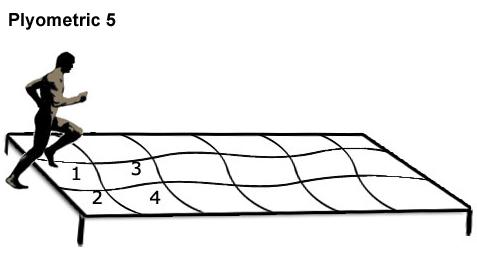Jumping is more than just a physical skill—it’s a form of expression, a burst of energy that can elevate both your body and spirit. Whether you’re an athlete looking to enhance your performance on the field or someone who simply wants to reach new heights in your fitness journey, improving your jumping ability can unlock a world of possibilities. Understanding the challenges that come with building this skill, this guide is designed to support you every step of the way. We’ll explore techniques, exercises, and tips that cater to various fitness levels, ensuring you can make meaningful progress at your own pace. So, let’s leap into this journey together and discover how you can boost your jumping prowess, while also nurturing your overall well-being.
Understanding the Fundamentals of Jumping Mechanics
Jumping is a complex skill that involves a harmonious interplay of multiple body systems. At its core, effective jumping requires the integration of strength, coordination, and timing. To enhance your ability to jump, it’s crucial to understand the mechanics that underpin this explosive movement. The following components are key to mastering the fundamentals:
- Force Production: The power generated from your leg muscles is pivotal. Focus on exercises that strengthen your quadriceps, hamstrings, and calves to boost your jumping power.
- Body Alignment: Proper posture and alignment can significantly affect your jump height. Ensure your knees are aligned over your toes and your core is engaged to maintain balance and maximize lift.
- Arm Swing: Don’t underestimate the role of your arms. A vigorous arm swing helps generate upward momentum and contributes to the overall force of your jump.
| Component | Role in Jumping |
|---|---|
| Strength | Generates the power needed to leave the ground. |
| Coordination | Ensures all body parts work in sync. |
| Timing | Optimizes the sequence of movements for peak performance. |

Tailoring Your Strength Training for Explosive Power
Unleashing your explosive power requires a strategic approach to strength training, focusing on exercises that enhance fast-twitch muscle fibers. These fibers are crucial for activities that demand sudden bursts of energy, such as jumping. Begin by incorporating plyometric exercises like box jumps, depth jumps, and squat jumps into your routine. These exercises are designed to increase your power output and improve your neuromuscular efficiency.
- Box Jumps: Start with a box height you are comfortable with and gradually increase as you gain confidence and strength.
- Depth Jumps: Step off a box and immediately jump as high as possible upon landing, which trains your body to react quickly and powerfully.
- Squat Jumps: Focus on exploding upward from a squat position, maximizing your jump height with each repetition.
Additionally, integrate strength exercises that target key muscle groups involved in jumping. Compound movements such as squats, deadlifts, and lunges should form the backbone of your regimen. Consider varying your training with different weight loads and repetition ranges to stimulate muscle growth and strength adaptations. Here’s a simple breakdown:
| Exercise | Reps | Sets |
|---|---|---|
| Squats | 6-8 | 3-4 |
| Deadlifts | 5-7 | 3-4 |
| Lunges | 10-12 | 3 |
Remember, the key to effective strength training for explosive power lies in balancing intensity and recovery. Listen to your body, ensuring you allow adequate rest between sessions to optimize performance and prevent injury. With dedication and the right approach, your jumping ability will see significant improvements.

Incorporating Plyometric Exercises for Enhanced Performance
To elevate your jumping ability, incorporating plyometric exercises into your routine is a game-changer. These explosive movements are designed to increase power, speed, and agility, transforming your performance in sports and daily activities. By focusing on the rapid stretching and contracting of muscles, plyometrics enhances the efficiency of your neuromuscular system, allowing you to jump higher and with more control.
- Box Jumps: Start with a box or platform at a manageable height. Jump onto the box with both feet, ensuring a soft landing, then step down. This exercise builds explosive strength in your legs.
- Depth Jumps: Begin by standing on a box. Step off and land on the ground, immediately jumping vertically as high as possible. This exercise helps in developing reactive strength.
- Lateral Bounds: Leap side-to-side over an imaginary line or low hurdle. Focus on quick, explosive movements to improve lateral agility and leg power.
| Exercise | Benefits |
|---|---|
| Box Jumps | Enhances leg power and coordination |
| Depth Jumps | Boosts reactive strength and speed |
| Lateral Bounds | Improves agility and lateral movement |
When starting plyometrics, it’s crucial to maintain proper form and start with lower intensity exercises, gradually increasing the difficulty as your body adapts. Listening to your body and ensuring adequate rest between sessions can prevent injuries and promote optimal performance improvements. Remember, consistency is key to unlocking the full potential of these dynamic exercises.

Adopting a Holistic Approach to Nutrition and Recovery
Improving your jumping ability isn’t just about working out your legs or perfecting your technique. It’s also about ensuring that your body has the right fuel and the time to recover properly. A holistic approach to nutrition and recovery can significantly enhance your performance and minimize the risk of injury.
- Balanced Diet: Focus on a diet rich in proteins, complex carbohydrates, and healthy fats. These macronutrients are essential for muscle repair and energy replenishment. Incorporate foods like lean meats, whole grains, and avocados.
- Hydration: Keep your body well-hydrated to maintain muscle function and prevent cramps. Water is crucial, but consider adding electrolytes for optimal performance.
- Recovery Time: Allow your muscles to rest and recover by getting adequate sleep and incorporating rest days into your training schedule.
| Food | Benefit |
|---|---|
| Quinoa | High in protein and fiber, supports muscle recovery |
| Sweet Potatoes | Rich in carbs and potassium, boosts energy |
| Salmon | Contains omega-3 fatty acids, reduces inflammation |








































